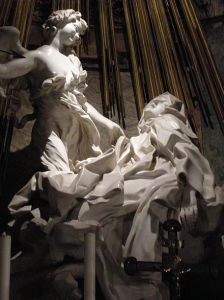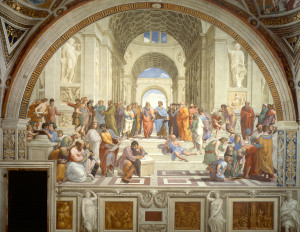Rome’s Top 5 Most Famous Works of Art
Posted on November 17th, 2014 by Anna in Uncategorized | No Comments »
For art lovers across the world, Rome can be a sensory overload. Located at the heartland of the Renaissance, it has some of the western world’s most stunning and legendary pieces of art, which manifest themselves as paintings, sculptures, and buildings. The city has more art museums than anyone could visit in a year, and the enormous amounts of sites to see and galleries to look at can be overwhelming. If you need some direction in what you absolutely have to check off your bucket list, here is some of Rome’s most famous artwork.
 The Ecstasy of St. Teresa. A baroque masterpiece in marble sculpted by Gian Lorenzo Bernini, this is a very dramatic piece representing a mystical religious frenzy as described by the Carmelite nun, Teresa of Avila. Melding the erotic and the spiritual, the statue depicts a swooning St. Teresa being attacked by an angel bearing a lance – considered by art historians to be Bernini’s iconic work. Location: Cornaro Chapel, Santa Maria della Vittoria
The Ecstasy of St. Teresa. A baroque masterpiece in marble sculpted by Gian Lorenzo Bernini, this is a very dramatic piece representing a mystical religious frenzy as described by the Carmelite nun, Teresa of Avila. Melding the erotic and the spiritual, the statue depicts a swooning St. Teresa being attacked by an angel bearing a lance – considered by art historians to be Bernini’s iconic work. Location: Cornaro Chapel, Santa Maria della Vittoria- The School of Athens. Painted in 1509 by Raphael, this fresco is a depiction of the philosophers of Classic Greece, idealizing reason and human knowledge as was in vogue at the time of its creation. The trompe l’oeil design gives the painting a sense of depth and perspective, and its collection of all the great thinkers of the ancient world makes it one of the Renaissance’s finest homages to the society it venerated. Location: the Apostolic Palace in the Vatican
- La Pieta. Another sculpture by Michelangelo, this statue of the Virgin Mary holding her son’s body is considered by many to be the artist’s finest work. Not only does it have astonishing detail in the folds of the subjects’ garments down to the depiction of veins and musculature in their arms, but the sense of tenderness and sorrow is perfectly captured. It is also unusual for the surprising youth and beauty of the Virgin Mary. Location: St. Peter’s Basilica
- Equestrian Statue of Marcus Aurelius. If you have more antiquated artistic tastes, check out the larger than life statue of the Roman emperor Marcus Aurelius. Over four meters tall and riding horseback, this bronze statue gives a forceful impression of the godlike status held by Roman emperors. The original is on display in the Capitaline Museums, but you can see a contemporary replica in the Piazza del Campidoglio.

- The Tomb of Pope Alexander VII. Less universally renowned than other Renaissance opuses, this elegant sepulcher is nevertheless a prime example of the skilled and highly lavish of the type of work commissioned in the Renaissance. Designed by Gianlorenzo Bernini, it is a metaphorical depiction of the Pope surrounded by figures depicting four virtues and Death. Sculpted in marble, jasper, and bronze, it still serves as an especially dramatic memento mori. Location: St. Peter’s Basilica
Whether you are an aficionado of Renaissance art or not, each of these five works is such an important addition to Rome’s cultural heritage that it would be nearly a sacrilege to miss out on them. Prepare yourself for your trip to Rome, whatever your motives are, by checking out our various levels of Italian courses, or sending us an inquiry for more information.




